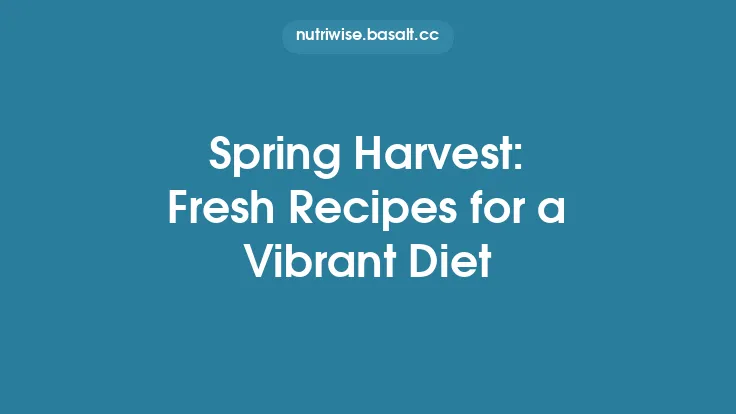When the clock is ticking and the sink is already full, the idea of a satisfying dinner that requires only a single pan can feel like a culinary miracle. The good news is that with a few strategic choices—smart ingredient pairings, efficient cooking techniques, and a little prep foresight—you can consistently pull together flavorful meals in 30 minutes or less while keeping cleanup to a bare minimum. Below is a comprehensive guide that walks you through the why, what, and how of 30‑minute one‑pan meals, giving you a toolbox of ideas you can adapt to any taste, diet, or pantry stock.
Why One‑Pan Meals Work for Busy Lifestyles
Speed through the cooking process – When everything happens in the same vessel, you eliminate the time spent moving dishes from stove to oven to countertop. Heat builds quickly, and flavors meld as the ingredients share the same cooking environment.
Reduce cleanup – One pan means one pot, one skillet, or one Dutch oven to wash. If you line the pan with parchment, foil, or a silicone mat, you can often toss the liner straight into the trash or recycling, leaving the pan virtually spotless.
Maximize flavor – The natural fond (the caramelized bits that stick to the bottom of the pan) becomes the base for a quick pan sauce, turning a simple collection of ingredients into a cohesive, restaurant‑quality dish.
Flexibility for any diet – By swapping proteins, grains, or vegetables, the same cooking method can serve omnivores, vegetarians, vegans, or those following gluten‑free or low‑carb plans.
Core Components of a 30‑Minute One‑Pan Meal
1. Protein (the star)
Choose cuts that cook quickly:
| Protein | Ideal Cut | Approx. Cook Time (minutes) |
|---|---|---|
| Chicken | Breast strips, thin thighs | 8‑10 |
| Beef | Sirloin strips, ground beef | 5‑7 |
| Pork | Tenderloin medallions, ground pork | 7‑9 |
| Seafood | Shrimp, scallops, firm white fish fillets | 3‑5 |
| Plant‑based | Firm tofu cubes, tempeh slices, canned beans (drained) | 5‑8 |
2. Carbohydrate Base (makes the meal filling)
- Quick‑cooking grains: Minute rice, couscous, quinoa flakes, or pre‑cooked brown rice (available in microwaveable pouches).
- Starchy vegetables: Diced potatoes (par‑boiled or thinly sliced), sweet potato rounds, or cauliflower “rice.”
- Legume shortcuts: Canned lentils or chickpeas, rinsed and drained.
3. Vegetables (color, texture, nutrients)
Pick a mix of:
- Fast‑sautéing: Bell peppers, snap peas, zucchini, spinach, kale, mushrooms.
- Pre‑cut or frozen: A bag of mixed stir‑fry vegetables or a medley of frozen broccoli florets can shave minutes off prep.
4. Flavor Builders (the glue)
- Aromatics: Garlic, shallots, ginger, or scallions—minced or thinly sliced.
- Acid: A splash of citrus juice, vinegar, or a dollop of tomato paste.
- Umami: Soy sauce, miso, Worcestershire, fish sauce, or a spoonful of anchovy paste.
- Heat: Crushed red pepper, fresh chilies, or a dash of hot sauce.
5. Finishing Touches (texture & brightness)
- Fresh herbs (cilantro, parsley, basil)
- Nuts or seeds (toasted almonds, sesame seeds)
- A drizzle of oil (chili oil, herb‑infused olive oil)
- A squeeze of lemon or lime at the table
Step‑by‑Step Workflow for a 30‑Minute One‑Pan Meal
- Mise en place (5 min)
- Measure out sauces, spices, and liquids.
- Cut protein into bite‑size pieces; pat dry to ensure browning.
- Slice vegetables uniformly for even cooking.
- Pre‑heat the pan (1 min)
- Use a heavy‑bottomed skillet, sauté pan, or a cast‑iron Dutch oven.
- Add a thin layer of oil with a high smoke point (e.g., avocado or grapeseed).
- Sear the protein (5‑8 min)
- Work in batches if the pan is crowded; crowding causes steaming instead of browning.
- Once a golden crust forms, remove to a plate and set aside.
- Build the base
- Add aromatics; sauté 30 seconds to 1 minute until fragrant.
- Toss in vegetables that need the most time first (e.g., carrots, potatoes).
- Stir‑fry or sauté, adding quicker‑cooking veggies later.
- Deglaze & create sauce (2‑3 min)
- Pour a splash of broth, wine, or water, scraping the fond.
- Stir in soy sauce, tomato paste, or other umami agents.
- Let the mixture reduce slightly; this concentrates flavor.
- Re‑introduce protein & carbohydrate (5‑7 min)
- Return the seared protein to the pan.
- Add the quick‑cooking grain or pre‑cooked starch.
- Toss everything together, allowing the starch to absorb the sauce.
- Finish & plate (2 min)
- Adjust seasoning with salt, pepper, and acid.
- Sprinkle fresh herbs, nuts, or a drizzle of oil.
- Serve directly from the pan or transfer to a serving dish.
Total time: ≈ 30 minutes (including prep).
Flavor Profiles & Sample Recipes
Below are four ready‑to‑use templates that illustrate how the same core workflow can produce wildly different meals. Feel free to swap ingredients while preserving the timing structure.
1. Mediterranean‑Inspired Skillet
- Protein: Thinly sliced chicken breast
- Carb: Orzo (pre‑cooked in the same pan)
- Veggies: Cherry tomatoes, Kalamata olives, spinach
- Sauce: Lemon juice, white wine, oregano, garlic, a pinch of smoked paprika
- Finish: Crumbled feta, chopped fresh basil, a drizzle of extra‑virgin olive oil
2. Asian‑Fusion Shrimp & Rice Noodles
- Protein: Large shrimp, peeled and deveined
- Carb: Rice noodles (softened in hot water, then added)
- Veggies: Snow peas, shredded carrots, sliced scallions
- Sauce: Soy sauce, rice vinegar, ginger, garlic, a spoonful of peanut butter for creaminess
- Finish: Toasted sesame seeds, cilantro, a squeeze of lime
3. Southwest‑Style Beef & Quinoa Bowl
- Protein: Ground beef seasoned with cumin, coriander, and chipotle powder
- Carb: Quick‑cook quinoa (pre‑rinsed)
- Veggies: Black beans, corn kernels, diced red bell pepper
- Sauce: Tomato sauce blended with chipotle in adobo, a dash of lime juice
- Finish: Avocado slices, chopped cilantro, a dollop of Greek yogurt (optional)
4. Vegan Coconut Curry Tofu & Cauliflower “Rice”
- Protein: Firm tofu, pressed and cubed
- Carb: Riced cauliflower (pre‑riced or pulsed in a food processor)
- Veggies: Broccoli florets, sliced bell peppers, snap peas
- Sauce: Coconut milk, red curry paste, lime zest, a splash of soy sauce
- Finish: Chopped peanuts, fresh mint, a drizzle of chili oil
Each of these dishes can be assembled, cooked, and plated within the 30‑minute window, and the cleanup is limited to the single pan used throughout.
Equipment Recommendations for Minimal Cleanup
| Tool | Why It Helps | Maintenance Tips |
|---|---|---|
| Heavy‑bottomed skillet (10‑12 in) | Even heat distribution prevents hot spots, ensuring proteins brown nicely without burning. | Hand‑wash with a non‑abrasive sponge; a quick soak removes stuck bits. |
| Cast‑iron Dutch oven | Retains heat for a quick reduction of sauces; can go from stovetop to oven if you want a brief finish. | Lightly oil after each use; avoid soap if seasoned well. |
| Silicone liner or parchment paper | Provides a non‑stick surface; can be lifted out and tossed, leaving the pan clean. | Rinse after use; silicone can be placed in the dishwasher. |
| Multi‑purpose kitchen shears | Cuts protein, veggies, and herbs quickly, reducing the need for a cutting board. | Wash immediately to prevent odor buildup. |
| Measuring spoons with built‑in magnetic strip | Keeps spices organized on the side of the pan, minimizing extra bowls. | Wipe dry after each use to avoid rust. |
Pantry Staples That Make One‑Pan Success Possible
- Oils: Avocado, grapeseed, and extra‑virgin olive oil.
- Acids: Balsamic vinegar, rice vinegar, lemon & lime juice (fresh or bottled).
- Umami boosters: Soy sauce, tamari, Worcestershire, miso paste, anchovy paste.
- Spice blends: Italian seasoning, Cajun mix, curry powder, smoked paprika.
- Broths: Low‑sodium chicken, beef, or vegetable stock (store‑bought or homemade).
Having these items on hand means you can assemble a sauce in seconds, turning a simple sauté into a fully flavored dish without hunting for missing ingredients.
Time‑Saving Tips & Tricks
- Pre‑portion proteins: Keep frozen chicken strips or pre‑cubed tofu in zip‑top bags; pull out a single portion when needed.
- Use “instant” grains: Minute rice, quick‑cook quinoa, or pre‑cooked barley cut cooking time dramatically.
- Batch‑cook aromatics: Roast a tray of garlic cloves and onions, then store in the fridge for up to a week. They’ll add depth to any sauce.
- Cold‑water shock for potatoes: Cut potatoes thinly, soak in cold water for 5 minutes, then pat dry. This removes excess starch, leading to crispier edges and faster cooking.
- Layer flavors early: Add a pinch of salt while sautéing vegetables; it draws out moisture and concentrates taste, reducing the need for later seasoning adjustments.
Adapting to Dietary Preferences
- Gluten‑free: Swap wheat‑based noodles for rice noodles or spiralized zucchini; use tamari instead of soy sauce.
- Low‑carb/Keto: Replace grains with cauliflower rice or shirataki noodles; increase the proportion of non‑starchy vegetables.
- Vegetarian/Vegan: Use beans, lentils, tempeh, or tofu as the protein base; choose vegetable broth and plant‑based sauces.
- Paleo: Opt for sweet potato cubes, almond flour‑based thickening agents, and coconut aminos in place of soy sauce.
Because the method hinges on a single pan, you can swap any component without reworking the entire cooking timeline.
Troubleshooting Common Issues
| Problem | Likely Cause | Quick Fix |
|---|---|---|
| Food steams instead of browns | Pan not hot enough; overcrowding. | Pre‑heat the pan longer; cook protein in batches, giving each piece space. |
| Sauce is too thin | Not enough reduction; excess liquid from vegetables. | Increase heat after adding the liquid, stir frequently, and let it reduce 2‑3 minutes. |
| Starch remains undercooked | Grain added too early or not pre‑cooked. | Use pre‑cooked grains or add them after the sauce has thickened, allowing a brief soak. |
| Vegetables become mushy | Over‑cooking or cutting them too large. | Cut veggies uniformly, add quick‑cooking ones last, and keep the heat at medium‑high. |
| Pan sticks despite oil | Oil burned or pan not properly seasoned. | Use oil with a higher smoke point; if using cast iron, ensure it’s well‑seasoned. |
Planning Ahead for Consistent Success
- Weekly inventory check – Every Sunday, glance through your fridge, freezer, and pantry. Note which proteins, grains, and vegetables are abundant, then sketch a rough menu of 3‑4 one‑pan meals.
- Prep “grab‑and‑go” kits – Portion out spices, sauces, and chopped veggies into zip‑top bags. Store them in the freezer or fridge for instant assembly.
- Label leftovers – If you have extra sauce or cooked grains, label them with the date. They can be repurposed in a new one‑pan dish later in the week, further reducing waste.
By integrating these habits, the 30‑minute one‑pan routine becomes a seamless part of your everyday cooking rhythm rather than an occasional novelty.
Final Thoughts
One‑pan meals are more than a convenience hack; they’re a strategic approach to home cooking that respects your time, your kitchen space, and your palate. By mastering the core components—quick‑cooking proteins, versatile starches, a colorful array of vegetables, and a handful of flavor‑building ingredients—you can spin out a limitless variety of dishes in half an hour or less. The key lies in preparation, the right equipment, and a willingness to let the pan do the heavy lifting.
Next time you glance at the clock and wonder what’s for dinner, remember that a single skillet, a splash of sauce, and a few pantry staples are all you need to create a wholesome, delicious meal with virtually no cleanup. Happy cooking!





